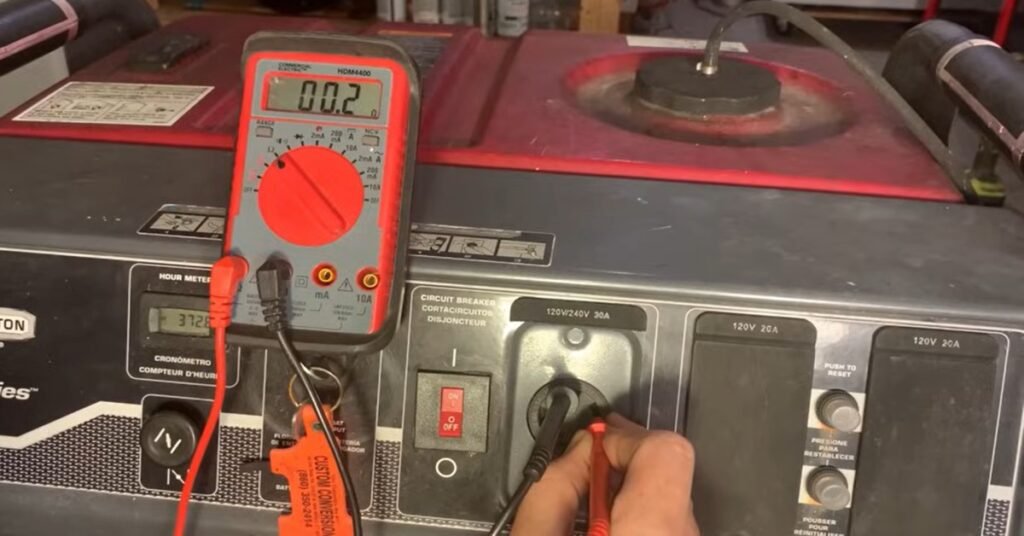Disclosure: This post contains affiliate links and I will be compensated if you make a purchase after clicking through my links. Learn More
How to test a generator voltage regulator, follow these steps: read the generator’s manual, locate the regulator, inspect its wires and connections, test the generator’s voltage output using a multimeter. Properly testing the generator’s voltage regulator is crucial to ensure its efficient performance and longevity.
By following the steps outlined in this guide, you can accurately test the regulator and address any issues that may arise, ensuring the smooth and reliable operation of your generator. Whether you are a seasoned DIY enthusiast or a first-time generator owner, this article will provide you with the necessary information to test your generator’s voltage regulator effectively.

Understanding The Generator Voltage Regulator
A generator voltage regulator plays a crucial role in maintaining a steady and reliable power supply. By controlling the voltage output of the generator, it ensures that the electrical equipment connected to the generator receives a stable and consistent power supply. In this section, we will explore what a generator voltage regulator is, discuss its importance in power generation, and delve into its functions and components.
What Is A Generator Voltage Regulator?
A generator voltage regulator is an essential component in power generation systems. It is responsible for regulating the output voltage of the generator, ensuring it remains within the specified range. The voltage regulator monitors the generator’s output and adjusts the excitation current flowing into the generator’s field winding. This, in turn, controls the generator’s output voltage, maintaining it at the desired level.
Importance Of The Generator Voltage Regulator In Power Generation
The generator voltage regulator plays a crucial role in power generation for several reasons. Firstly, it helps to maintain a consistent voltage level, ensuring that connected electrical equipment receives a steady power supply. This voltage stability is vital for sensitive electronic devices and prevents potential damage caused by voltage fluctuations.
Additionally, the voltage regulator helps protect the generator from overloading. By regulating the voltage output, it prevents excessive stress on the generator’s internal components, which can lead to inefficiency, overheating, and even failure.
Furthermore, a well-functioning voltage regulator improves the overall efficiency of the generator. By controlling the output voltage, it optimizes the generator’s performance, avoiding unnecessary energy wastage. This not only helps save fuel but also extends the lifespan of the generator, reducing maintenance and replacement costs.
Functions And Components Of The Generator Voltage Regulator
The generator voltage regulator performs various functions to ensure a stable output voltage. Some of its primary functions include:
- Monitoring the output voltage of the generator
- Adjusting the excitation current to regulate the generator’s output voltage
- Compensating for voltage variations caused by changes in load
- Protecting the generator from overvoltage and under-voltage conditions
- Providing voltage stability and ensuring a consistent power supply
The generator voltage regulator consists of several key components that work together to fulfill its functions:
| Component | Description |
|---|---|
| Voltage Sensing Circuit | Monitors the output voltage of the generator |
| Reference Circuit | Provides a reference voltage for the regulator |
| Error Amplifier | Compares the reference voltage with the sensed voltage and generates an error signal |
| Power Device | Controls the excitation current to regulate the output voltage |
These components work in harmony, ensuring that the generator voltage regulator functions efficiently and reliably to maintain a steady output voltage. Regular testing of the voltage regulator is essential to identify any issues or malfunctions that may affect the generator’s performance.
Signs Of A Faulty Generator Voltage Regulator
A generator voltage regulator plays a crucial role in maintaining a stable voltage output and protecting electrical devices from potential damage. However, like any other electrical component, it can experience malfunctions over time.
Recognizing the signs of a faulty generator voltage regulator is vital to ensure the smooth operation and longevity of your generator. In this section, we will discuss the common symptoms of a malfunctioning voltage regulator, the impact it can have on generator performance, and how to identify warning signs and troubleshoot the issue effectively.
Common Symptoms Of A Malfunctioning Voltage Regulator
When a generator voltage regulator starts to fail, it exhibits specific signs that indicate there might be an underlying problem. Identifying these symptoms early on can help prevent further damage and potential generator failure. Here are some common signs to look out for:
Unstable voltage output: A faulty voltage regulator may cause voltage fluctuations, resulting in unstable power output. This can lead to unstable operation of electrical devices connected to the generator, which could be potentially damaging.
Overvoltage or undervoltage issues: A malfunctioning voltage regulator can cause the generator to produce excessively high or low voltages. Overvoltage can overload electrical appliances, while undervoltage can lead to poor performance or even equipment failure.
Inconsistent power supply: If you notice intermittent power supply interruptions or sudden loss of power, it could be a sign of a faulty voltage regulator. Fluctuating or inadequate power supply can disrupt your activities and cause inconvenience.
Generator not starting or difficulty in starting: A malfunctioning voltage regulator can prevent the generator from starting altogether. Alternatively, it may make it challenging to start the generator, requiring multiple attempts before it eventually starts.
Flickering lights or dimming: Dimming or flickering lights while the generator is running can be indicative of a voltage regulator problem. This can affect various electrical devices and appliances, causing them to operate inefficiently or not at all.
Understanding The Impact Of A Faulty Voltage Regulator On Generator Performance
A faulty voltage regulator can have a significant impact on the performance and longevity of your generator. When the voltage regulator fails to regulate the voltage output properly, it can lead to adverse consequences, such as:
Reduced lifespan of electrical devices: Excessive voltage output can put additional strain on electrical appliances and equipment connected to the generator. This can shorten their lifespan and increase the need for frequent repairs or replacements.
Potential damage to sensitive electronics: Inaccurate voltage regulation can cause damage to sensitive electronic devices, such as computers, televisions, or smartphones. These devices require a stable power supply to function correctly, and fluctuations can lead to permanent damage.
Overheating of electrical components: Inefficient voltage regulation can result in overheating of electrical components within the generator. This can lead to premature wear and tear, increased maintenance costs, and even pose a fire hazard.
Unreliable generator performance: A faulty voltage regulator can compromise the overall stability and reliability of the generator. This can result in inconsistent power supply, frequent breakdowns, and the inability to meet power demand during critical situations.
Identifying Warning Signs And Troubleshooting Techniques
Identifying the warning signs of a faulty generator voltage regulator allows you to take necessary measures to rectify the issue promptly. If you notice any of the symptoms mentioned earlier, here are some troubleshooting techniques to help diagnose the problem:
- Perform a visual inspection: Check for any visible signs of damage or loose connections in the voltage regulator and its associated wiring.
- Measure voltage output: Use a multimeter to measure the voltage output coming from the generator. Compare the readings with the manufacturer’s recommended range to determine if it falls within acceptable limits.
- Consult the generator manual: Refer to the generator’s manual for specific troubleshooting steps and instructions provided by the manufacturer.
- Seek professional assistance: If you are uncertain or unable to troubleshoot the voltage regulator issue yourself, it is advisable to seek the help of a professional technician or electrician who specializes in generator repairs.
By staying vigilant and proactive in identifying and addressing a faulty voltage regulator, you can ensure optimal performance and reliability from your generator for years to come.
Testing The Generator Voltage Regulator
Testing the generator voltage regulator is an important step to ensure that your generator is functioning optimally and providing the correct voltage output. A malfunctioning voltage regulator can cause voltage fluctuations, which can damage electrical appliances and equipment connected to the generator. In this guide, we will walk you through step-by-step on how to test the generator voltage regulator to ensure its accuracy and performance.
Tools And Equipment Needed For Testing The Voltage Regulator
Before you can begin testing the generator voltage regulator, it is important to gather the necessary tools and equipment. Here is a list of what you will need:
| Tools | Equipment |
|
|
Step-by-step Guide To Testing The Generator Voltage Regulator
Follow these step-by-step instructions to test the generator voltage regulator:
- Make sure the generator is turned off and disconnect it from any electrical load.
- Locate the voltage regulator on the generator. It is usually mounted near the generator’s control panel.
- Use the flathead screwdriver to remove the screws holding the voltage regulator cover in place.
- Once the cover is removed, visually inspect the regulator for any signs of damage or burnt components.
- Next, connect the test leads of the multimeter to the voltage regulator terminals. The specific terminals may vary depending on the generator model.
- Set the multimeter to the voltage measurement mode and turn on the generator.
- Checking the output voltage:
Using the multimeter, measure the voltage output of the generator. The voltage reading should match the rated voltage of your generator. If the voltage reading is significantly higher or lower than the rated voltage, it indicates a problem with the voltage regulator.
Evaluating The Regulator’s Response
While the generator is running and supplying power, observe the regulator’s response:
- Check if the voltage stabilizes and remains constant within an acceptable range. A fluctuating voltage indicates a faulty regulator.
- Inspect the regulator for any signs of overheating, such as excessive heat or burning smell. This can be an indication of a malfunctioning voltage regulator.
Testing The Voltage Regulation Accuracy
To ensure the voltage regulation accuracy of your generator’s voltage regulator, perform the following:
- Connect an electrical load, such as an appliance or a light bulb, to the generator.
- Measure the voltage output while the electrical load is connected and running.
- Compare the voltage reading with the rated voltage. The voltage should stay within a certain percentage of the rated voltage, usually around ±5%. If the voltage deviates significantly from the rated voltage, it indicates a problem with the voltage regulator.
Testing the generator voltage regulator is an essential maintenance task to ensure your generator operates safely and efficiently. By following the steps outlined above, you can identify and resolve any voltage regulation issues, ensuring that your generator performs optimally when you need it the most.
Troubleshooting And Maintenance
Proper troubleshooting and maintenance of your generator’s voltage regulator are crucial to ensure its efficient performance and a longer lifespan. In this section, we will discuss various techniques and tips to help you identify and resolve common voltage regulator issues, as well as measures to maintain its optimal functionality.
Troubleshooting Techniques For Common Voltage Regulator Issues
Identifying and resolving voltage regulator issues promptly can prevent further damage and costly repairs. Here are some techniques you can employ:
- Check for loose connections: Inspect the wiring connections between the generator and the voltage regulator. Loose or corroded connections can cause voltage fluctuations. Ensure all connections are secure and clean.
- Measure voltage output: Use a multimeter to measure the voltage output. Connect the multimeter probes to the voltage output terminals of the generator. If the voltage reading deviates significantly from the manufacturer’s specifications, it indicates a potential issue with the voltage regulator.
- Inspect for physical damage: Examine the voltage regulator for any signs of physical damage, such as broken wires, burnt components, or leaking capacitors. Physical damage can affect the regulator’s performance and functionality.
- Test the voltage regulator: If you suspect a faulty voltage regulator, you can test it using a suitable testing device or consult a professional for assistance. This will help you accurately diagnose the problem and determine if the regulator needs to be repaired or replaced.
Maintenance Tips To Prolong The Lifespan Of The Voltage Regulator
Regular maintenance of the voltage regulator will contribute to its longevity and reliable performance. Consider the following tips:
Keep the area clean: Ensure that the area around the generator and voltage regulator is clean and free from debris. Dust and dirt can hinder the cooling capabilities of the regulator and cause overheating.
Check for proper ventilation: Verify that the voltage regulator has sufficient ventilation to dissipate heat. Poor ventilation can lead to overheating and potential damage.
Inspect the voltage regulator regularly: Perform periodic inspections to detect any signs of wear and tear, loose connections, or other issues. Regular maintenance will help you address any problems early on and prevent further damage.
Follow manufacturer’s recommendations: Adhere to the manufacturer’s maintenance guidelines for your specific voltage regulator model. This includes recommended intervals for servicing and replacing components, such as capacitors or resistors.
Importance Of Regular Inspections And Preventive Measures
Regular inspections and preventive measures are crucial to ensure the efficient operation and longevity of the voltage regulator. By implementing these measures, you can:
Identify and resolve potential issues before they escalate: Regular inspections allow you to detect any developing issues or signs of wear and tear. By addressing these problems promptly, you can prevent them from causing more significant damage or breakdowns.
Reduce the risk of unexpected generator failure: A well-maintained voltage regulator is less likely to malfunction and cause sudden generator failure. Regular upkeep increases the reliability of your generator system, ensuring uninterrupted power supply when you need it.
Prolong the lifespan of the voltage regulator: By following proper maintenance practices and conducting regular inspections, you can extend the lifespan of your voltage regulator. This helps you avoid premature replacement costs and ensures continued efficient performance.
By troubleshooting voltage regulator issues effectively and implementing regular maintenance measures, you can ensure that your generator operates optimally and provides reliable power when needed.
Read more: How to safely run a generator in a garage?
FAQs For How To Test A Generator Voltage Regulator?
How Do I Test A Voltage Regulator With A Multimeter?
To test a voltage regulator with a multimeter, follow these steps:
1. Set the multimeter to the voltage testing range.
2. Connect the multimeter’s positive probe to the regulator’s output pin.
3. Connect the multimeter’s negative probe to the regulator’s ground pin.
4. Measure the voltage displayed on the multimeter.
5. If the voltage is within the specified range, the regulator is functioning properly.
Note: Make sure to consult the specific regulator’s datasheet for accurate voltage range.
How Do You Know If A Voltage Regulator Is Bad?
You can determine if a voltage regulator is bad by checking for symptoms like dimming headlights, fluctuating or unstable voltage output, or electrical devices not working properly. Additionally, you can use a multimeter to test the voltage regulator’s output voltage and continuity.
How Do You Test A Generator Avr With A Multimeter?
To test a generator AVR with a multimeter, first, set the multimeter to measure AC voltage. Then, turn on the generator and connect the multimeter’s leads to the generator’s output socket. Finally, check if the multimeter displays a consistent voltage reading within the manufacturer’s specified range.
How Do You Test A Voltage Regulator To See If It’s Working?
To test a voltage regulator, connect a multimeter to the battery terminals, start the vehicle, and measure the voltage. If it’s within the specified range (usually around 13. 8-14. 5 volts), the regulator is working fine.
Conclusion
To conclude, testing a generator voltage regulator is a crucial step in ensuring the smooth and efficient operation of your generator. By following the simple steps outlined in this blog post, you can easily determine if your voltage regulator is functioning properly or if it requires repair or replacement.
Remember, regularly testing and maintaining your generator’s voltage regulator will help prevent power fluctuations and potentially costly damage. So don’t delay, take the time to test your generator’s voltage regulator today for peace of mind tomorrow.


